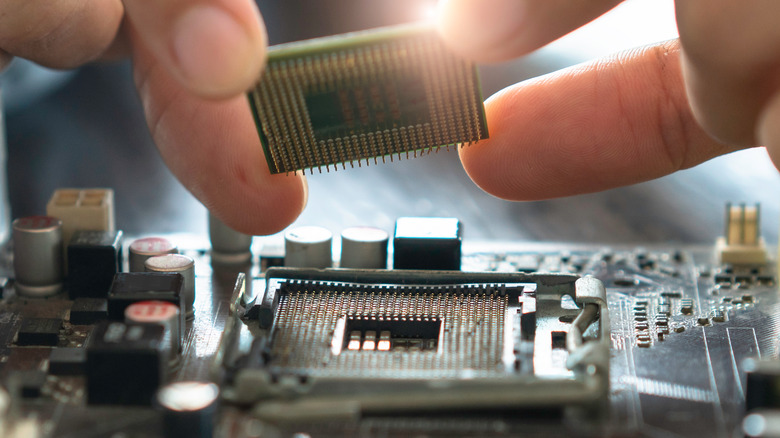The World's Smallest Computer Is Smaller Than You Think
IBM and the University of Michigan have had an ongoing competition for who can create the world's smallest computer. As of June 2018, Michigan is winning. That month, the university unveiled a new micro-computer 10 times smaller than IBM's. It's about .3 mm in length per side, far smaller than a grain of rice (via The University of Michigan).
Despite its tiny size, the computer has random-access memory, a processor, and wireless transmitters and receivers. They receive and transmit data using visible light rather than radio antennae, as is conventionally used, because they're too small for the antennae to fit (via The University of Michigan). According to Digital Trends, the computer also has a base station that, along with an LED transmission light, gives the computer power. The light is converted to electricity via a process called photovoltaics.
According to the university, to achieve this, Michigan engineers had to create a new type of circuit that's low-power but can tolerate light. The light from the base station and LED light create the circuit's currents. They also had to make sure the computer's readings were highly accurate despite the low power. Three Michigan professors of electrical and computer engineering worked on developing the computer: David Blaauw, Dennis Sylvester, and Jamie Phillips.
What constitutes a computer?
Following the release of IBM's micro-computer, a few months before Michigan's, there was some debate as to whether these devices could even be called computers. Insider notes that Michigan's .3 mm device does have a processor, which puts it nearer to being a "real" computer. However, it does not retain programming and data once it's disconnected from power. All previous computers did, up until IBM's device, released in March 2018.
Blauuw admitted, "We are not sure if they should be called computers or not. It's more of a matter of opinion whether they have the minimum functionality required" (via The University of Michigan).
The developers of the Michigan micro-computer had to use diodes (semiconductors) instead of capacitors to direct currents in the computer, which lessened the effects of light on the computer but risked increasing the electrical noise it made. However, this doesn't affect its definition as a computer (via TechRadar).
How can this micro-computer be used?
According to the university, the Michigan micro-computer is, essentially, a temperature sensor. It converts temperatures into time intervals and is accurate within .1 degrees Celsius. Gary Luker, a professor of radiology and biomedical engineering, collaborated on the project and hopes it can be used in the field of oncology, to measure the temperature of tumors. Tumors are believed to be hotter in temperature than other types of cells, but this hasn't yet been conclusively proven. If the micro-computer could prove it, it could then also be used to detect tumor growth early (via TechRadar).
That's not its only potential use, however. According to another university article, Michigan's previous smallest computer — 2x2x4 mm in size — has been used to study small snails in the Society Islands in the South Pacific. By attaching the computers to snails, researchers were able to determine why one species survived an event that wiped out most other snail species native to the islands. Other potential uses for the new micro-computer include oil reservoir monitoring, biochemical process monitoring, audio-visual surveillance, and diagnosing glaucoma from inside the eye.


